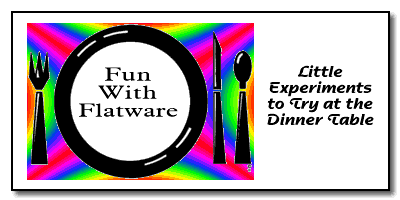

What is needed
The Spoon: What to Do
The Spoon: What is Happening
OK, here's the scoop: the spoon is a mirror, but because of its shape, it's either a convex mirror (if you look at the back of the bowl) or a concave mirror (if you look at the front.) These kinds of mirrors disort the images that they make. A convex mirror - like the back of the spoon - makes the image smaller and right side up. A concave mirror - like the front of the spoon - makes an image that can be small or large, and right side up or upside down. The key is how close you are to the mirror. The image is usually upside down, and the closer you are to the mirror, the larger the image, up to a certain point. Beyond this point, the image flips right side up. Concave mirrors are the kinds of mirrors that get used in telescopes.
The Knife: What to Do
The Knife: What is Happening
Basically, you are just using the knife as a small mirror. As you look at the reflection of things in the mirror, you can explore how they are reversed and changed. It's also fun to make a pattern by looking at something directly with its image in the knife right above it.
I have been known to entertain myself this way at a Chinese restaurant (with a placemat with lots of words and pictures) for the better part of an hour.
What to do: The Fork
The Fork: What is Happening
If you have good stainless forks, or, even better, silver, they will vibrate very nicely. Pinging the tines starts a good vibration. Now, when you touch the end of the fork to the table, the table acts as a sounding board - and makes it so you can hear the vibration. It is playing the same role as the body of a violin or other stringed instrument.
Other Things to Try
If you can get a good vibration on your fork, try putting the tines in your water glass (best if there is no ice.) This makes a nice effect. And you might try the images in different spoons; soup spoons in particular let you get a very up-close-and-personal view of, say, the inside of your nose. This is a fascinating way to spend dinner, especially if you share your observations with others at the table.
|
Follow-up 1. What two shapes describe the surfaces of a dinner spoon? Which side of the spoon is which shape? 2. Which spoon surface makes an image that can be small or large, and right side up or upside down? 3. You are the knife as a small __?__. Describe how images can be made to change when viewed with a knife. 4. What type of forks seem to vibrate well? "Pinging the tines." What the heck is a tine anyway? 5. What method is used to make it so you can hear the vibration? How is the body of a violin similar to the table top? 6. What happened when you put the vibrating tines (We know what that is right?) of the fork into the water glass?
|